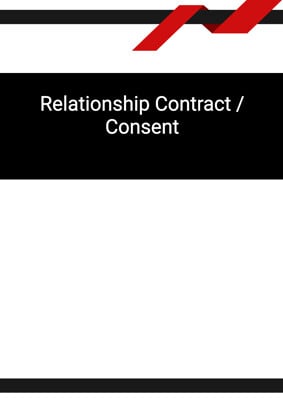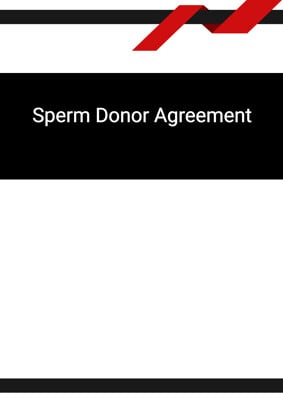How to Tailor the Document for Your Need?
01
Create Document
Fill in the details of the parties. You can click the "Fill with Member’s Information" button to complete it with information saved to your account.
02
Fill Information
Please fill in any additional information by following the step-by-step guide on the left hand side of the preview document and click the "Next" button.
03
Get Document
When you are done, click the "Get Document" button and you can download the document in Word or PDF format.
04
Review Document
Please get all parties to review the document carefully and make any final modifications to ensure that the details are correct before signing the document.
Document Preview
Document Description
The Relationship Contract/Consent document is an agreement between two parties who desire to enter into an intimate relationship. The document outlines the expectations of their relationship, specifically focusing on intimate acts and other activities they agree to engage in. It also covers aspects such as protection, escalation of activities, withdrawal of consent, privacy and confidentiality, mutual release, health and safety, costs, enforceability, and governing law.
The document begins by acknowledging that Relationship Contract/Consent document is a legally unenforceable and potentially controversial agreement. This document may be regarded as immoral or even illegal in some places, so it barely serves the purpose of evidence of the parties' willingness to engage in intimate activities.
The first section of the document, titled 'Intimate Acts,' states that both parties agree to engage in sexual activities. The second section, titled 'Other Activities,' allows the parties to consent to additional activities beyond sexual acts. If applicable, the use of a specific device is also included.
The third section, titled 'Protection,' addresses the use of protection by both parties. If one party requires protection, the duration of its use is specified. The fourth section, titled 'Escalation,' outlines the conditions under which engaging in activities beyond the initial consent is allowed. Depending on the chosen option, a new and separate consent, adding activities to the existing consent, or verbal mutual consent may be required.
The fifth section, titled 'Withdrawal of Consent,' explains that either party may withdraw their consent at any time by providing written notice to the other party. If consent is withdrawn during the course of the activities, any activities conducted prior to and within one minute after the withdrawal are still considered consented. If the withdrawing party's last-minute withdrawal results in costs or expenses for the other party, the withdrawing party is responsible for those expenses.
The sixth section, titled 'Privacy and Confidentiality,' emphasizes the importance of keeping the terms of the consent and any private information confidential. Both parties agree not to take any recordings or make any public postings without consent. However, the parties are allowed to provide this consent to the police, court, or legal advisor as evidence of their intent.
The seventh section, titled 'Mutual Release,' releases each party from any obligation or liability under the activities and any claims arising from the consent, except for breaches of the consent. This also covers the risk of pregnancy.
The eighth section, titled 'Health and Safety,' requires both parties to represent that they do not carry any sexually transmitted diseases, are not currently pregnant, and do not have any other diseases that may be transmitted through the proposed activities. Proper hygiene, including showering before the activities, is expected from both parties.
The ninth section, titled 'Costs,' states that if the meeting takes place at a paid establishment, such as a hotel, the costs will be paid by the responsible party unless otherwise agreed.
The tenth section states that third parties have no rights to enforce the terms.
The eleventh section addresses the enforceability of the agreement. If any provision is found to be invalid or unenforceable, the remaining provisions will still be in effect. The parties may substitute the invalid provision with a similar enforceable term under consent.
The twelfth and final section states that the agreement and the relationship between the parties will be governed by and interpreted under the jurisdiction state law. The document concludes with the signatures of both parties and, if applicable, a witness signature.
Overall, this Relationship Contract/Consent document serves as a detailed agreement between two parties entering into an intimate relationship, outlining their consent, rights, responsibilities, and expectations.
How to use this document?
To effectively use the Relationship Contract/Consent document, follow these steps:
1. Provide information: Enter the names and addresses of both parties, Party A and Party B, in the agreement. This ensures that both parties are clearly identified.
2. Consent to intimate acts: Indicate the specific intimate activities that Party A and Party B consent to engage in. This ensures that both parties are aware of and agree to the scope of their intimate activities.
3. Consent to other activities: If there are additional activities beyond sexual acts that the parties consent to, specify them in this section. If applicable, indicate the use of any specific device.
4. Specify protection: If Party A or Party B requires protection, state the type of protection and the duration of its use. This ensures that both parties are aware of and agree to the necessary precautions.
5. Address escalation of activities: Depending on the chosen option, either require a new and separate consent, allow the addition of activities to the existing consent, or establish verbal mutual consent for escalated activities. This ensures that both parties understand the conditions for engaging in activities beyond the initial consent.
6. Clarify withdrawal of consent: Explain that either party may withdraw their consent at any time by providing written notice to the other party. If consent is withdrawn during the activities, specify that any activities conducted prior to and within one minute after the withdrawal are still considered consented. Additionally, address the financial responsibility of the withdrawing party for any resulting costs or expenses.
7. Emphasize privacy and confidentiality: Highlight the importance of keeping the terms of the consent and any private information confidential. Prohibit the taking of recordings or making of public postings without consent. However, allow the parties to provide this consent as evidence to relevant authorities.
8. Establish mutual release: State that each party releases the other from obligations, liabilities, and claims related to the activities, except for breaches of the consent. This ensures that both parties understand the extent of their release from liability.
9. Address health and safety: Require both parties to represent that they do not carry any sexually transmitted diseases, are not currently pregnant, and do not have any other diseases that may be transmitted through the proposed activities. Emphasize the importance of proper hygiene, including showering before the activities.
10. Discuss costs: If the meeting takes place at a paid establishment, clarify who is responsible for covering the costs. If necessary, allow for alternative agreements regarding costs.
11. Understand enforceability: Explain that the agreement's enforceability may vary depending on jurisdiction. If any provision is found to be invalid or unenforceable, allow the parties to come to an agreement and substitute the invalid provision with a similar enforceable term.
12. Sign the agreement: Ensure that both parties sign the agreement to indicate their consent and understanding of the terms. If desired, include a witness signature for additional validity.
By following these steps, both parties can establish clear boundaries, expectations, and consent within their intimate relationship while ensuring their legal rights and responsibilities are protected.
Not the right document?
Don’t worry, we have thousands of documents for you to choose from:















